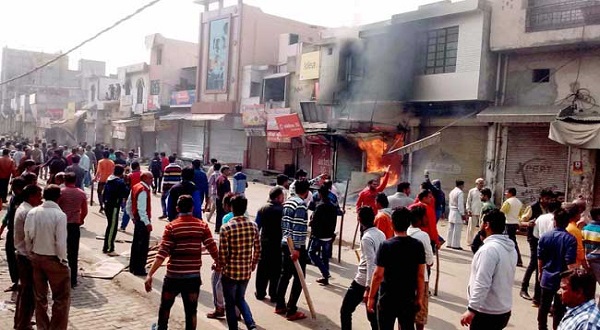Jat protest in Haryana, which started off as a mild rallying on February 14, took a violent turn as it escalated into a wild protest that left at least 30 dead and over 200 injured. No matter how far-fetched it may sound, the JNU row was also a cause for triggering the recent violence. According to police reports and eyewitness accounts, the Jat protest began peacefully on 14th in Sampala.
Haryana has 36 castes living in the state. On February 18th, however, a group of about 150 men, belonging to the business community, began to march through the town. They were chanting and shouting slogans against the blockades organized by the Jats. On the way, they found part of the road blocked by lawyers protesting on the JNU row. The group mistook the lawyers for a pro – Jat quota blockade, which resulted in a heated argument. It eventually turned into a fight and the lawyers were beaten up, as said by a police spokesperson.
The lawyers retreated and the group marched on. At Sonipat bus stand, a larger group of lawyers accosted the traders and allegedly beat them up. Meanwhile, as news spread that lawyers had been beaten up by non –Jats, a group of students protesting for Jat quota marched towards Chhotu Ram Chowk, where they clashed with the traders.
“The two groups pelted stones and beat each other up. They also torched vehicles; as many as four bikes were set on fire. Police had to resort to lathi charge to disperse them.” said the police spokesperson.
The Jat agitation has left at least 30 dead and over 200 injured. Haryana police has so far arrested 127 people for indulging in violence during the 10 – day agitation, and registered 535 FIRs, said DGP Yash Pal Singhal. There has also been a report that at least 10 women were raped during the protest, although there is no concrete evidence to support that as no FIRs had been filed. Police are yet to receive any information regarding the matter. DGP Yash Pal Singhal also added that stringent action would be taken if they received any information. According to a newspaper report, Jat rioters set fire to dozens of cars on a highway connecting Haryana to Delhi during the protests, forcing to occupants to flee. The rioters then stripped and raped 10 women in the nearby fields, it added. Media reports alleged the police and administrative authorities urged the women to not come forward and register any complaint to ‘save their honor’ – which was denied by senior police and administrative authorities. On Wednesday, the Punjab and Haryana High Court asked the state government to launch an investigation into the allegations.
Large scale violence began in Haryana on 19th February and for the next few days, Jat protestors went on a rampage, ravaging everything that stood in their way. They set fire to vehicles, shops and properties owned by the non–Jats. Similar demonstrations were also held in Delhi, Punjab, Himachal Pradesh and Jammu and Kashmir.
Reason behind the Jats anger –
The Jat community took to the streets and employed violent and intimidating means to achieve their goal. They want job quotas similar to those granted to the lower castes. The Jats were traditionally affluent and has been seen as upper caste. But recently, the demonstrators had been demanding their inclusion into the job and education quotas, which had been made available to the lower castes since 1991. In March 2014, the Congress-led national government said that it would re-categorise Jats as Other Backwards Castes (OBC), thus opening up the job quotas. But in 2015, the Supreme Court ruled that the Jats were not a backward caste and their case was thrown out. Now the community has again demanded the reinstatement of their backwards caste status to enable them to secure government jobs as farming incomes have declined and jobs in private sectors have dried up.
The caste – creed system has always been a hurdle in India for a long time. All the inequalities that it entails have caused nothing but grief.





